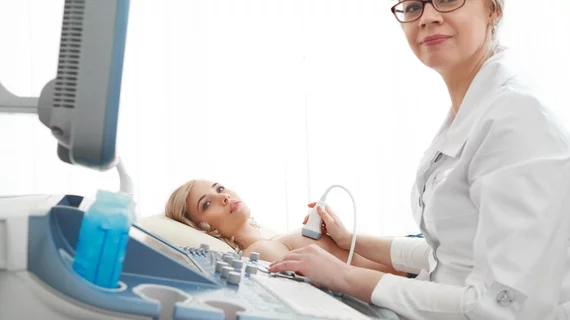Ultrasound alone detects 92% of breast cancers recalled on DBT exams
Noncalcified lesions observed on digital breast tomosynthesis exams signal that additional imaging is necessary to rule out malignancy. But rather than obtaining additional mammographic views, research suggests using ultrasound alone may be sufficient.
The American Journal of Roentgenology recently published a study that dives deeper into the ultrasound versus mammography discussion. For the research, doctors examined 430 recalled noncalcified lesions in 399 women to determine whether ultrasound alone is a suitable recall tool compared to incorporating ultrasound in conjunction with additional mammographic views.
“We hypothesized that omitting diagnostic mammography for the evaluation of recalled noncalcified abnormalities from screening DBT might help greatly reduce non-additive diagnostic mammography without missing cancers,” corresponding author, Jessica H. Porembka, MD, with the Department of Radiology at the University of Texas Southwestern Medical Center, and co-authors explained.
Ultrasound alone was performed on 306 lesions, while it was used in addition to mammography for 124 lesions. Needle biopsy was performed on 93 lesions, 38 of which were found to be invasive cancers. Ultrasound alone detected 92% of the cancers (35 out of 38). The other three were discovered using US and additional mammographic views.
“Performing US first in the evaluation of noncalcified masses recalled on screening DBT can help reduce the number of women receiving non-additive diagnostic mammography,” the doctors noted. “Because noncalcified lesions make up a large number of recalled lesions, downstream omission of radiation exposure could be significant.”
Although the results of the study suggest that ultrasound alone is sufficient for recall imaging of most noncalcified lesions, the authors caution that not all lesions are created equal. Some findings, like asymmetries, may require diagnostic mammography, while architectural distortion is best visualized with both ultrasound and mammography combined, or even with contrast-enhanced MRI.
You can view the detailed research in the American Journal of Roentgenology.
Related Breast Imaging Technology Content:
DBT plus synthesized mammography drops patients’ dosage without losing imaging quality
3D mammography approaching 50% of breast imaging systems in the US
Breast MRI screening cuts cancer mortality rates in half for women with lesser-known gene mutations
DBT spot compression views increase reader accuracy
Digital breast tomosynthesis outperforms DM at detecting malignancy in developing asymmetries
AI drops DBT workloads for radiologists by 40% while also reducing recalls
Less experienced radiologists are more susceptible to fatigue when reading DBT exams
Stand-alone AI can reduce radiologists’ screening mammography workloads by 90%
Imaging center has credentials revoked following ‘severe’ issues with mammography screening
Q&A: Should COVID vaccinated patients delay getting breast imaging — new study says no

